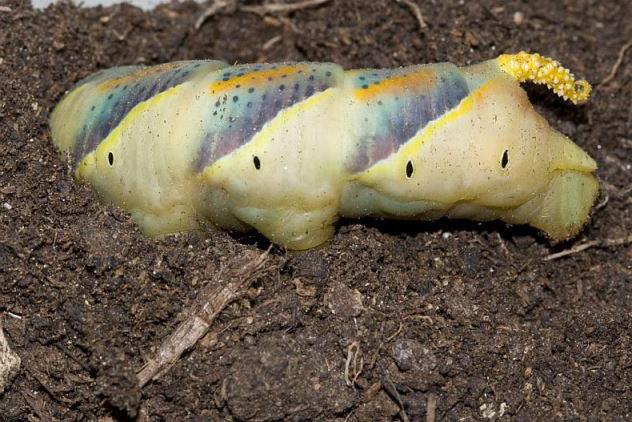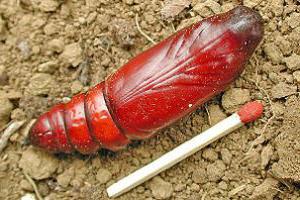Among the insects found on the territory of Russia, the largest is the dead-headed moth butterfly. The thickness of her body reaches 2 cm, length - 6 cm, and wingspan - 13 cm. This arthropod can hardly be called an insect. Rather, it looks like a bird or a winged beast. The “dead head” butterfly has long been a source of terror to people. Many legends are connected with it. Believe it or not, everyone decides for himself.
Butterfly related beliefs
It is believed that a meeting with a "dead head" portends the death of one of the family members. To prevent this, the butterfly should be killed.
If a flake from the wing of a hawk gets into the eye, this will lead to imminent blindness and imminent death.
In 1733, in France, the epidemic of smallpox killed thousands of human lives. Superstitious Frenchmen associated the advent of adversity with the appearance of a "dead head" in these places.
Is it possible that the “dead head” hawk is a butterfly that carries death, disease, war, epidemics, destruction and hunger? Of course, this is a monstrous heresy, although impressionable people still attribute such properties to a large insect. But butterflies are not even carriers of diseases dangerous to humans, unlike lice and many mammals.
Mystical butterfly in literature and cinema
Fear of her was fueled by writers. So, the science fiction writer Alexander Belyaev described the winged lepidopteran in the story “Dead Head”, giving the butterfly a fictitious gigantic size, and Edgar Poe, famous for his mystical novels, used this butterfly in the Sphinx to catch more fear on the protagonist. Susan Hill in the Gothic novel “I am King in the Castle” inspired terror in one of the characters using the anatomical features of the insect.
Cinematographers have repeatedly included hawker in a thriller script to exacerbate an atmosphere of fear.
In Silence of the Lambs, the killer maniac puts a hawk doll in his victim’s mouth. He hopes this will help fulfill his desire to become a woman.
Ole Bornedal showed a cluster of moth butterflies in one of the episodes of the thriller Casket of Damnation, which was released in 2012.
The origin and meaning of the name
Brazhnik “dead head” in Latin atlas-classifiers is referred to as acherontia atropos. Acheron is one of the five rivers of the kingdom of the dead. By the same word the ancients denoted the deep and terrible netherworld. "Atropa" is translated as "inevitability, inevitable fate." This name is the goddess of fate, one of the three moira, the one that breaks the thread of human life.
In the vernacular of many peoples, a skull-like pattern with empty eye sockets and two bones, causing the same associations, was expressed in a similar way. Therefore, they call it everywhere almost in the same way - a butterfly “dead head” or “head of Adam”.
Butterfly scream is another cause for fear
The reason for human fear is the fact that the hawk is capable of emitting a piercing subtle cry, similar to a squeak. And he does it with his head, or rather with his mouth. For insects, this is not characteristic. Grasshoppers or cicadas that entertain our hearing with chirping in the summer emit it with their feet, and the hawk makes it with his mouth. His hearing organs are also located on his head.
An uninvited guest - a sign of trouble?
Another reason for signs was that the “dead head” butterfly is not a native and permanent resident of the European continent. Its homeland and permanent habitat is North Africa. In the countries of the Strict World, she is not always chosen. It depends on weather conditions, climate change, etc. Accurate information on this subject is not available. However, every year butterflies migrate to the northern regions. In other years, they get to Iceland to the north and to Iran to the east. On the territory of Russia, the “dead head” butterfly was found in Karelia, near Petrozavodsk and St. Petersburg. More often, she visits the Kaluga, Moscow, Penza, Smolensk, Saratov, Astrakhan and Volgograd regions, as well as the Krasnodar Territory and the Caucasus. Some sources indicate that they observed hawk even in Siberia - in the south of the Tyumen region. In the second generation, hawks females are sterile, and the population can only resume due to a new wave of migrants.

What drives these amazing animals from their native places? Probably, it’s still not a desire to bring information about impending disasters, but a banal search for food.
What does the scary butterfly eat?
What does a dead head butterfly eat? Her favorite foods are flower nectar and sweet wood juice. If juicy fruits come across, then she will drink their juice, although preference is given to liquid syrupy food. On the island of Madagascar, hawks pollinate orchids, since in some species of this butterfly the proboscis is longer than one and a half centimeters. Unlike other hummingbirds insects and birds, which are also pollinators of flowers, the hawthorn cannot freeze in flight over the object. He needs a solid footing. Such a support and a large amount of nectar are in beehives. "Dead head" - a butterfly, created by nature itself in order to eat honey from beehives. The sound that it makes is identical to that which the bees hear from a new uterus emerging from the cocoon. Interestingly, it can be heard not only from a butterfly, but also from a chrysalis and from a caterpillar. Bees, hearing a soothing squeak, do not perceive the hawk as an enemy and a robber. However, sometimes they still expose an uninvited guest. There have been cases when bees strangled the hawk to death, although it can withstand up to three bee stings without harming health.

Scary night demon
If you look at the photographs, the hawk-eared wings do not make a frightening impression at all. And what does the “dead head” butterfly look like at night? After all, hawthorn is a nocturnal butterfly. It can be seen at dusk when the sun goes down. Until midnight, huge insects circling in the light of street lamps or other sources of artificial light. These are mating dances of adult males and females. An unusually beautiful, albeit very rare sight. What does a dead-head hawthorn butterfly look like in night lighting? Very impressive - the head of a dead man with empty eye sockets and a hole instead of a nose clearly looms on a black velvet body. Superstitious horror will bother anyone, not just an exalted person with a subtle psyche. As the saying goes: "Everyone wants to go to heaven, but nobody wants to die." Nevertheless, one should not be afraid of a hawk.
This kind of butterflies has already gotten a lot from people. They are periodically listed in the Red Book as an endangered species. Being nocturnal animals, they do no harm, and there is a long-established method against penetrating hives. Beekeepers protect their honey from an uninvited guest with grids with openings of no more than one and a half centimeters. Bees and drones easily pass through them, but not hawks. These sweet tooth are too thick.
Caterpillars
In addition to apiaries, hawks can be found in the fields. In the old days, females laid eggs on potato beds. Their larvae happily fed on juicy tops. After the fields were massively cultivated against the Colorado potato beetle, the hawks stopped placing their offspring there. Caterpillars of the “dead head” butterfly can feed on foliage of other plants from the nightshade family - tomatoes, physalis, eggplant, nightshade, dope, belladonna. Being polyphages, dead head larvae also eat green tops of carrots, beets, and other root crops. They can live in gardens, absorbing the leaves of fruit trees and shrubs. During this period, they cause very significant damage to agriculture.
The butterfly lays bluish or greenish eggs in the sinuses between the leaves and the trunk of these plants, and also glues to the underside of the leaves. The eggs have a size of 1.2 to 1.5 mm. Larvae of the first age are covered with sparse hairs and are no longer than 1.2 cm long, and the last, fifth, already reach 15 cm and weigh up to 22 g. At the rear end of the caterpillar there is a growth that resembles a horn in shape. Hogworm larvae are very beautiful. They are bright green with oblique dark stripes. Among the leaves they are easy to miss. There are species with yellow-green color and even with white-blue.

For pupation, the caterpillars burrow into the ground to a depth of 40 cm. From time to time they crawl to the surface to eat. The caterpillar lives for about eight weeks before entering a pupal state. Pupae transform into a butterfly within a month. Shortly before going outside, they begin to make sounds characteristic of this type of arthropod. Female hawks are larger and rounded in shape compared to males. In the color of male specimens there is more black color, the pattern is sharper and more expressive. Usually, two life cycles of this species of insects occur during a year, but in good, especially warm summer, hawks are able to increase their reproduction cycle up to three times.
The colors of butterflies and larvae can be different, because the hawthorn has more than 1200 species. Yes, and the "dead head" itself, that is, a butterfly with the corresponding pattern on the body, also has a lot of varieties.
Hogweed - an integral part of biogeocenosis
Butterfly "dead head" makes a significant contribution to the global ecosystem of our planet. Large individuals pollinate plants with a pestle deep inside the flower. Other insects cannot cope with this work. Hornworms are a protein feed for a variety of fauna representatives - in the daytime, a sleepy nocturnal moth butterfly is an easy prey for many mammals and birds.